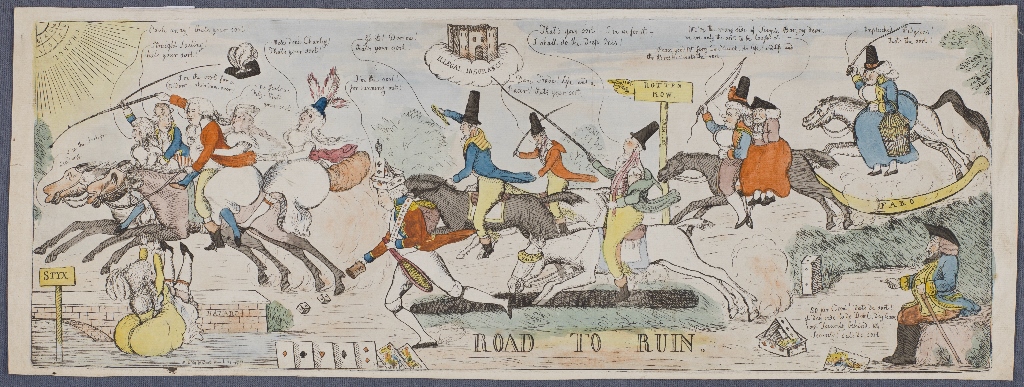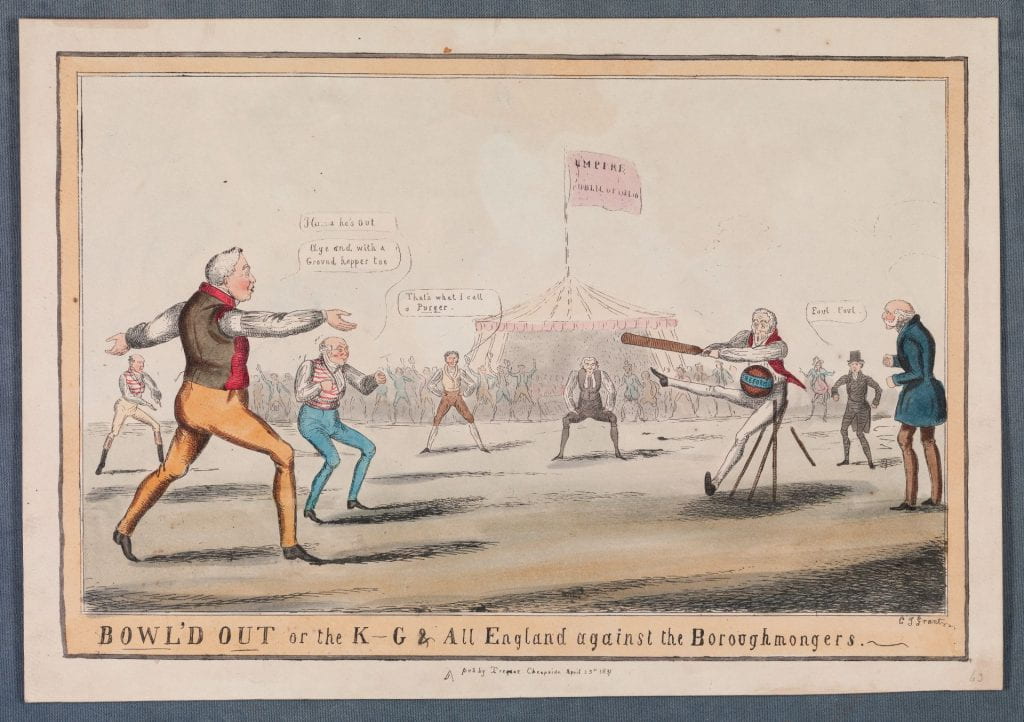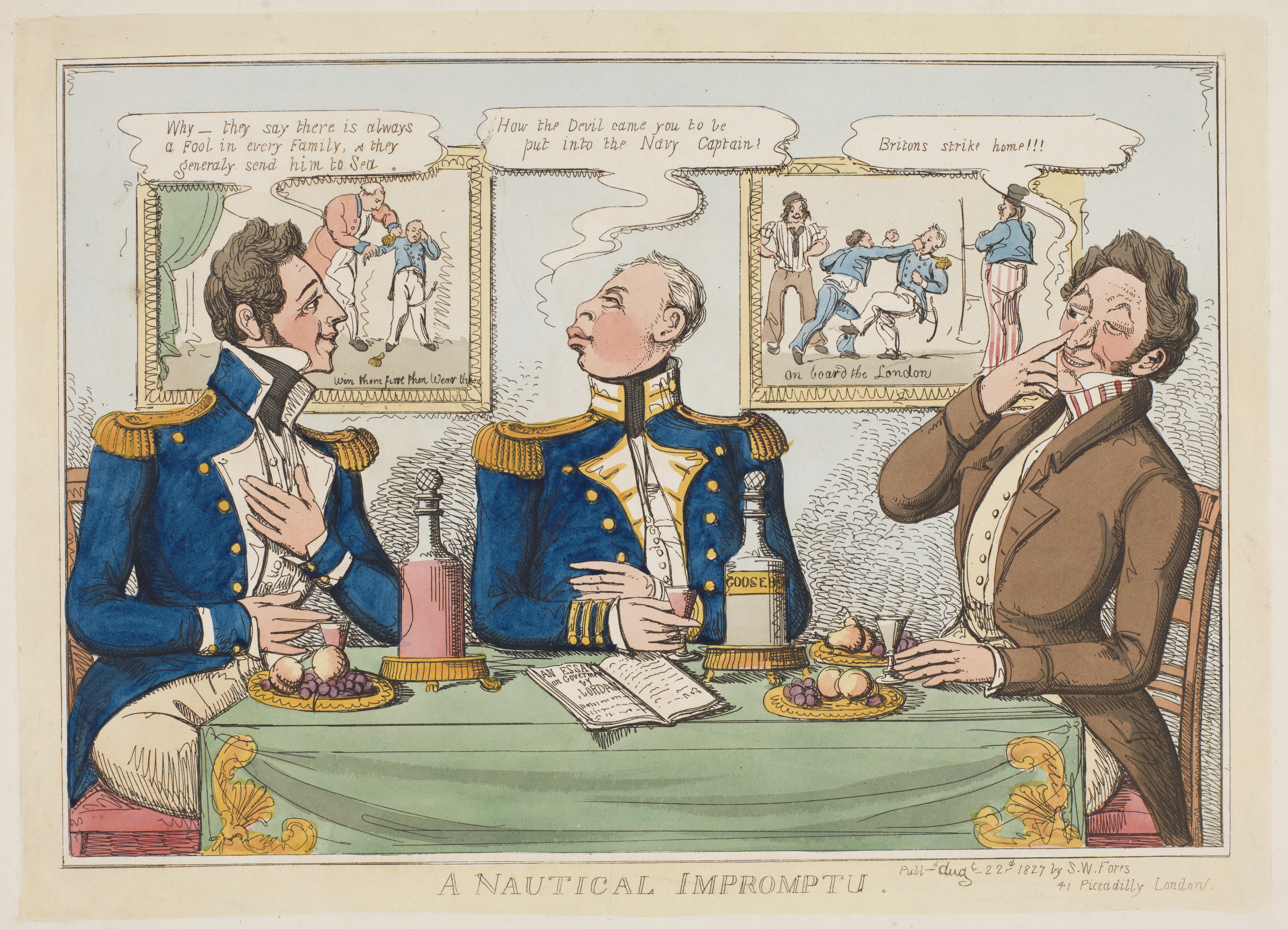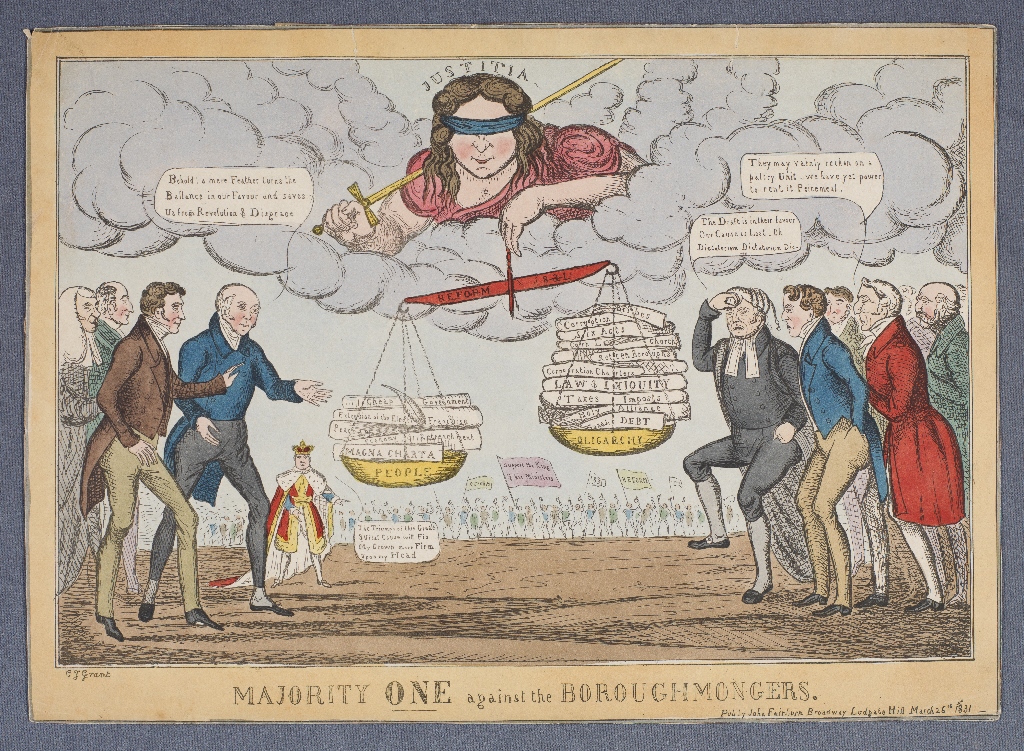
“Notorious rakes and gamblers ride or run furiously towards rays descending from a sun in the upper left corner of the design inscribed ‘Chance’; its centre, a segment of which is visible, is composed of the letters on an ‘E.O.’ (roulette) table (cf. British Museum Satires No. 5928). The foremost pair are the Duke of Clarence and the Prince of Wales; the Duke, slightly ahead, wears a chamber-pot on his head marked with an anchor (cf. British Museum Satires No. 7909) and sits behind Mrs. Jordan, who cries, “Push away! that’s your sort!” He cries, “Straight Sailing! that’s your sort!” Both the horses have human heads; that of the Duke says, “I’m the Sort for Leading; that of the Prince is Fox.” The Prince’s hat with feathers and the motto ‘Ich dien’ flies from his head, two women sit behind him; the one holding his waist (? Mrs. Crouch) says, “No Jealous Fitz – that’s your sort!” The other, seated behind her, holds the end of the Prince’s shirt, she has a large fox’s brush and is probably Mrs. Armistead; she says, “Well done Charley! That’s your sort!” The Prince says, “I’m the sort for a Widow – she’s done over!” Mrs. Fitzherbert has fallen from the horse into a stream and holds out her arms towards the Prince. From the water emerges a post inscribed ‘Styx’, a bridge or culvert beside it is ‘Hazard’. Behind this group the Duke of York runs forward, wearing a hat made of playing-cards surmounted by a teetotum inscribed ‘ABC….’ In his right hand he holds out a dice-box inscribed ‘Oat – ‘ shaking from it two dice inscribed ‘la’ and ‘nds’ (he had recently bought Oatlands); in his left is a tennis racquet. He wears regimentals; the ribbon across his shoulder is formed of playing-cards; at his back is a knapsack full of ‘Tennis Balls’ (cf. British Museum Satires No. 7903) which resemble guineas. He says, “I’m the sort! for running out!” For his gaming see British Museum Satires No. 7301 (5), &c. Just behind him ride three bloods with cropped hair, wearing the high hats, long breeches, and coats with shawl collars hanging away from the neck which such young men affected (see British Museum Satires No. 8040, &c). The one nearest the spectator rides a horse with a bandage over his eyes inscribed ‘Lottery Hack’; he looks up, regardless of the fact that he is riding into a pit, and points with his long whip to a castle resting on clouds inscribed ‘Illegal Insurance’ (cf. British Museum Satires No. 7750); he says, “That’s your sort – I’m in for it – I shall do the deep Ones!” The other two shout, “Go it! Dam’me! that ‘s your sort!” and “Dam Trade! Life and a Racer! that ‘s your sort.” Behind this group is a couple on a galloping horse: a stout jovial woman wearing breeches rides astride, waving her whip, behind her sits an anxious-looking elderly citizen, wearing petticoats. He says, “We’re the wrong side of Temple Bar, my dear, we are only the sort to be laughed at”; she answers, “Peace good Mr Jerry Candle-wick, its life! and Life and the Breeches! thats the sort.” By their horse’s head is a signpost inscribed ‘Rotten Row’, with a pointing hand inscribed ‘Hoyle’ (on Whist), the vertical post inscribed ‘Crim. con.’ The last rider is a stout woman, probably Mrs. Hobart (noted for her faro-table, see British Museum Satires No. 8167), on a rocking-horse inscribed ‘Faro’; she carries on her arm a wicker cage containing pigeons and says, “Unplucked Pidgeons! that’s the sort.” In the foreground on the extreme right an elderly Jew sits on a bank watching the mad race with a smile; he says, “50 per Cent! dats de sort! if dey ride to de Devil, dey leave coot Security behind, Ah! Security! dot’s de sort.” Near him is a card house; at his feet is the Knave of Clubs. In the front of the design and near the Duke of York are other playing cards (left to right): four aces, the two of diamonds, King of Hearts, and (?) Queen of Diamonds, the last two having some resemblance to George III and Queen Charlotte.”–British Museum online catalogue.
- Printmaker: Dent, William, active 1783-1793, printmaker.
- Title: Road to ruin [graphic].
- Publication: [London] : Pubd. by W. Dent, March 20, 1792.
Catalog Record & Digital Collection
792.03.20.02+
Acquired October 2016




